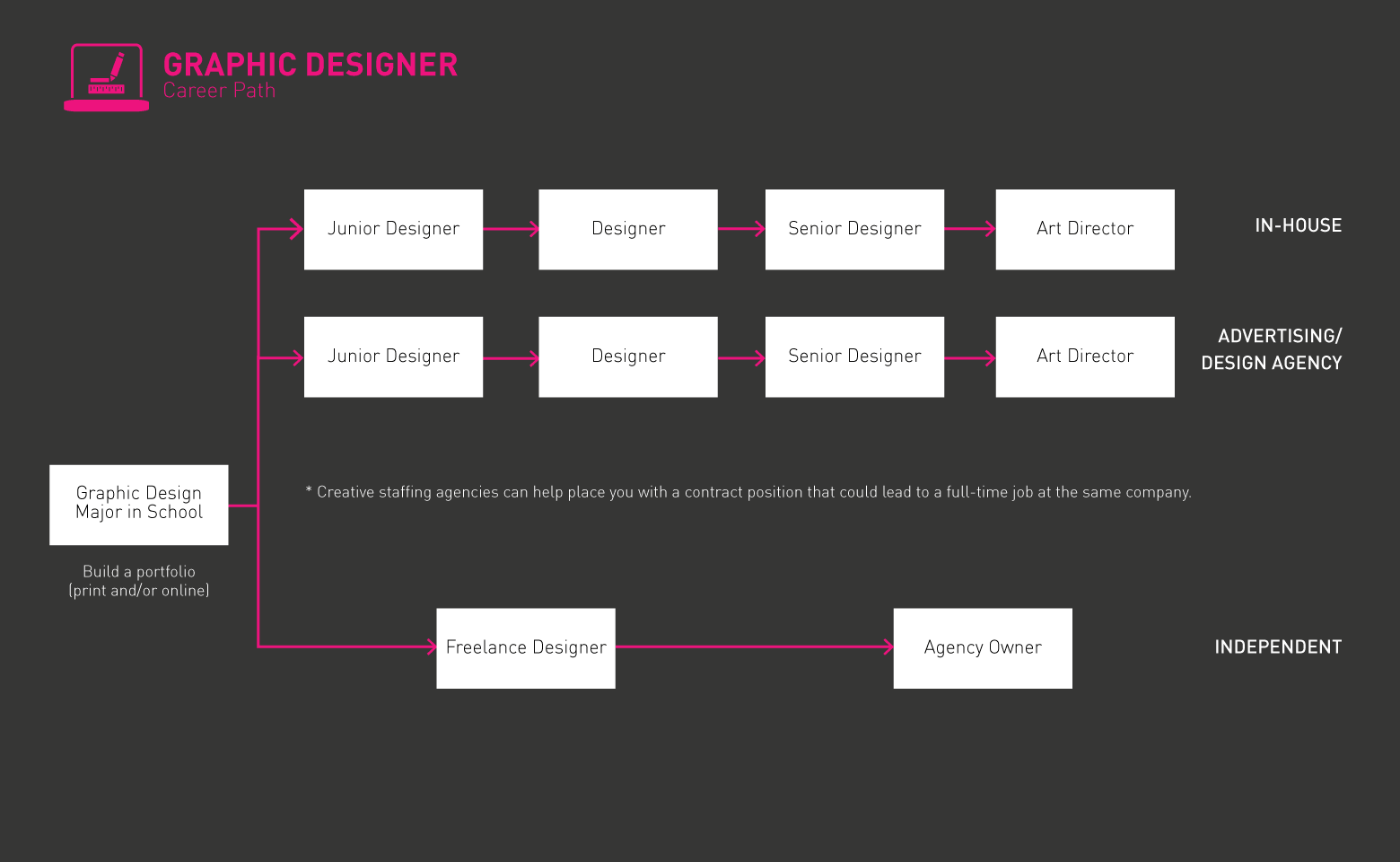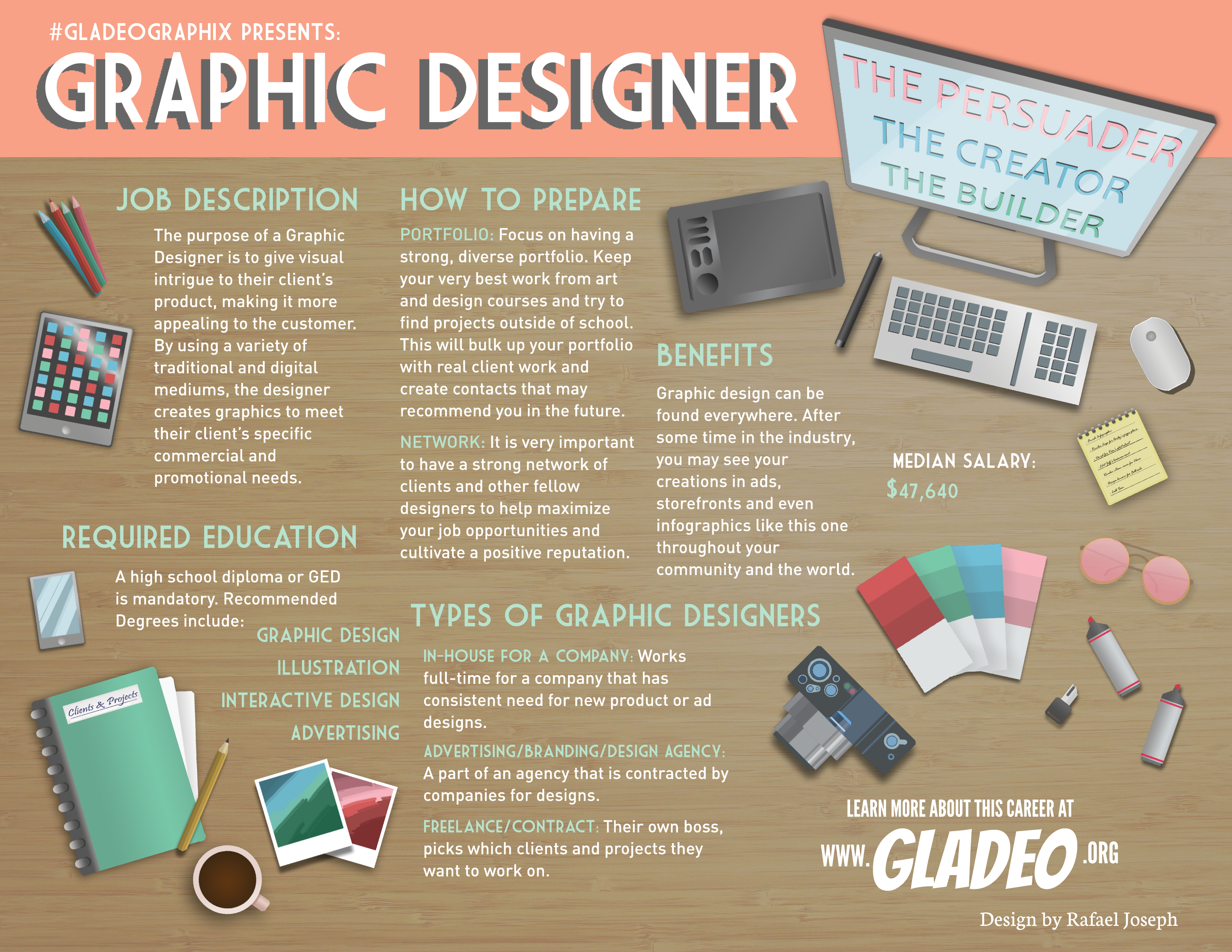Reflektory
Graphic Artist, Production Artist, Layout Artist, Multimedia Designer, Illustrator, Medical Illustrator, Web Designer
Graphic designers design or create graphics to meet specific commercial or promotional needs using a combination of typography, visual arts and page layout techniques to produce the final result. They may use a variety of mediums to achieve artistic or decorative effects.
- Seeing things you created in the store or on a website.
- Being creative.
- Getting to create something from scratch.
Hard Skills
- Software
- Adobe Photoshop
- Adobe Illustrator
- Adobe After Effects
- Adobe InDesign
- Sketch
- Canva
- Knowledge
- Design Principles
- Photo Composition
- Photo Editing
- Print Design
- Typography
- Conceptual Skills
- Design for digital media: more and more companies need designers for their web presence, apps or social media presence. Print is still prevalent but if you want to be marketable, you must understand the digital media space.
- Familiarity with Presentation Equipment
- Fine Arts
- Ideation: The creative process of generating, developing, and communicating new ideas, where an idea is understood as a basic element of thought that can be either visual, concrete, or abstract. Ideation comprises all stages of a thought cycle, from innovation, to development, to actualization.
- Layout Design
Umiejętności miękkie
- Attention to detail
- Project management skills
- Networking and “selling” yourself: Many graphic designers work project by project so they are constantly finding new clients and pitching their talent and services.
- Active Listening and communication skills: You must be able to digest your client’s needs and articulate your ideas and concepts both verbally and written.
- Empatia
- TIme Management: Lots of deadlines and handling many projects at the same time, so you need to know how to manage your time.
- Persistence: Design is subjective so there will be changes and some things will be scrapped. Be patient and take stuff in stride and stay persistent.
- In-House for a company: Working for a company that needs graphic design for their marketing or product.
- Advertising/Branding/Design Agency: An agency is hired by companies to advertise or brand their product.
- Freelance/Contract: You are your own boss. You work for many companies who need graphic design for their product or marketing of their product.
- Companies are using social media and constantly changing their websites, their Facebook page and e-mail campaigns. Thus, they need designers to constantly create new designs and pages.
- With the increased use of the Internet, designers will be needed to create designs and images for portable devices, websites, electronic publications, and video entertainment media.
- Drawing!: Just couldn’t stop doodling even during class.
- Liked creating the programs or posters for school activities (like prom, sports events…etc).
- Graphic Designers generally need a bachelor’s degree related to the subject, but other majors may be allowable as long as sufficient technical training has been completed
- Fine arts, illustration, and advertising may be suitable alternative majors
- The National Association of Schools of Art and Design lists accredited programs around the country that can provide ideal experiences for students seeking Graphic Design jobs. While these aren’t necessary, they can certainly help candidates stand out against the competition
- Roughly 23% of Graphic Designers hold an associate’s or certificate versus a bachelor’s
- Graphic Designers should be familiar with various software, such as Adobe Creative Cloud, Adobe Fireworks, FreeHand MX, Illustrator, Photoshop, CorelDRAW, SmugMug Flickr, and Trimble SketchUp
- You must also be comfortable using a wide range of hardware devices, including laptops, desktops, hard drives, tablets, styluses, smartphones, studio cameras, and high-res monitors
- If you eat, sleep, breathe, and obsess about art and your portfolio makes people weep, go to art school.
- If you like art, have a pretty good portfolio, think you want to earn a living as an artist but want to add some diversity to your education, go to university.
- Art school is pretty expensive and very hard to get a scholarship.
- Training at an art specific school might be better to learn how to conceive ideas to production. Some people say that state schools don’t always train you with the whole process. Some art schools train you on how to market yourself, get and retain clients.
- Practice drawing and using design software early and often, starting in middle or high school if possible
- It helps to load up on art classes, but many artists are self-taught, using books, YouTube tutorials, or just trial and error to hone their craft
- Use free tools to learn the basics and upgrade to paid professional tools when you can afford to and are ready to up your game
- Look for volunteer opportunities with local papers, arts and culture centers, or businesses that need help with their graphics
- Experiment with your style, techniques, and tools until you find the best ways to express yourself and represent your personal brand
- Think long term and work on projects you’ll be able to include in your portfolio. Study the portfolios of others and keep notes about any work that inspires you
- Reach out to working Graphic Designers; ask questions about how they got started and what recommendations they have for you
- Hop on freelance sites like 99Designs, Upwork, or Fiverr to get experience working with clients. Also consider taking some freelance work from an established agency
- Learn about the business side of things by reading or watching interviews with people in the field
- Don’t focus only on one type of Graphic Designer job; try to broaden your horizons and consider all the areas it is possible to work in
- 13% with HS Diploma
- 14% with Associate’s
- 43.1% with Bachelor’s
- 7% with Master’s
- 1.1% with Doctoral

- Must have a portfolio.
- Network!
- Sign up at a creative staffing agency: The agency might place you at a company as a temporary employee. A lot of the times, the temporary position turns into a full-time position.
- There is no shortage of talent entering the Graphic Design field, so to be competitive you’ll want to come in with academic and work-related experiences, as well as a solid portfolio
- Fortunately, just as there are a ton of aspiring Graphic Designers, there’s also a growing demand for ~261,400 of them by 2030!
- Completing an internship can help you get your foot in the door, gaining experience as well as potentially some great references. Some internships lead directly to jobs with the same company you interned with!
- Holding a certification in popular graphic design software is also a fast way to demonstrate your proficiency to employers. Adobe’s ~150-hour Certified Professional in Graphic Design & Illustration Using Adobe Illustrator is just one example
- It pays to stay connected with past professors, supervisors, and other colleagues so, when the time comes, they can help keep you posted about job openings…and put in a good word for you
- Create accounts on job portals such as Indeed.com; sign up for alerts so you’ll get notified of new job ads. Make sure you meet all the listed qualifications before applying
- Get connected with communities like the American Institute for Graphic Arts, the Graphic Design Subreddit, and GOTO Design to learn tips and get your work seen
- Study sample Graphic Design job interview questions and answers ahead of time!
Job Sites (both freelance and full-time positions)
Creative staffing agencies
- Get involved with AIGA – The Professional Association of Design.
- Stay up to speed with new technology/styles in the industry.
- Network!
- Freelance: write up contracts, know your rates, know timing (how long it takes to finish the project), under promise/over deliver!
- Raw talent.
- Being able to adapt quickly.
- Being able to work quickly, in a fast-paced environment.
- Taking direction and being creative at the same time.
Strony internetowe
- American Institute for Graphic Arts
- Council for Advancement and Support of Education
- GOTO Design
- Graphic Artists Guild
- Graphic Design Subreddit
- KelbyOne
- National Association of Schools of Art and Design
- Society for Experiential Graphic Design
- University and College Designers Association
Książki
- Graphic Artists Guild Handbook, Pricing & Ethical Guidelines, by The Graphic Artists Guild
- Graphic Design for Beginners: Fundamental Graphic Design Principles that Underlie Every Design Project, by Anita Nipane
- How to Think Like a Great Graphic Designer, by Debbie Millman
- Managing Corporate Design: Best Practices for In-House Graphic Design Departments, by Peter L. Phillips
“Seek out advice. There are probably a hundred job titles in the field of graphic design that are really different. Evaluate what you like about art and creating and try to talk to somebody that fits the route you are interested in.” - Chrissi Hernandez, Art Director, Sephora
Kanał informacyjny

Polecane oferty pracy

Kursy i narzędzia online









